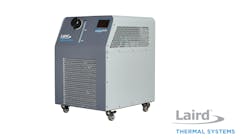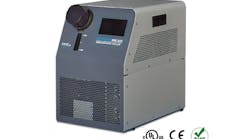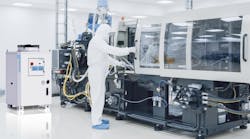Chiller Maintenance Tips: 3 Quick Questions with Tim Kane
A cold blast of reality is hitting many industrial facility managers: Inefficient chillers are leading to increased energy costs and reliability issues.
Typically, the reason is a lack of maintenance. Energy consumption can double in just a few years without routine chiller maintenance, according to Goodway Technologies, a global manufacturer and marketer of industrial maintenance and cleaning solutions.
A chiller is the single largest consumer of power and the most expensive piece of equipment in a building, explains Tim Kane, president and CEO of Goodway Technologies.
"Chillers account for over 50% of the electrical usage in most facilities, according to the North Carolina Energy Office," Kane says. "The U.S. Department of Energy estimates that chillers are expending up to an additional 30% in energy through inefficiencies. Regular maintenance of chiller systems helps decrease energy costs and extends operational efficiencies."
Several new advancements in chiller maintenance are helping facility managers and technicians improve reliability. Some of these technologies include quick-connect shafts and brushes, Speed Feed gun systems, and drop-in tube cleaning tablets.
NED recently spoke with Kane to gain a better understanding of how these systems work and how they can help improve efficiency and reliability in industrial facilities.
NED: What did the early days of chiller maintenance look like?
Kane: Chiller maintenance has certainly come a long way, though it's still quite a manual and labor-intensive process to do correctly.
Many years ago, the only option for cleaning chiller tubes was to attach a brush to a metal rod and clean out the tubes. This was extremely time-consuming and often required multiple people to get the job done. It could also cause worker injury because it required repetitive motions.
In all, cleaning a chiller, which in many cases has hundreds of tubes, could take many days. With today's technology, that time has been reduced to just a few hours.
As a result, the biggest advantage today is that efficient and easy-to-use tube cleaning equipment means that the job gets done instead of being pushed aside due to difficulty.
NED: What do you think the biggest innovations in chiller maintenance have been in the past five years?
Kane: There have been a few innovations that have not only sped up the process but also made the cleaning more impactful.
The introduction of technology like the Speed Feed gun system, allows the user to simply press a button to push and return the cleaning shaft and brush down the tube. This not only speeds up cleaning but reduces operator fatigue.
A more recent innovation includes quick-connect shafts and brushes. During the cleaning process, an operator can go through 25 to 50 brush changes or more. The quick-connect system eliminated the need to spend a few minutes for each brush change, saving valuable time and effort.
Another innovation was the introduction of variable-speed shaft rotation. Historically, tube cleaners have spun their brushes at a fixed rate. With the introduction of rifled or internally enhanced tubes to chillers and other heat exchangers, the fixed RPM tube cleaners could sometimes miss cleaning the valleys of these rifled tubes. Using a variable RPM machine allows the user to better match the natural grooving pattern of the rifling, assuring a better, more consistent cleaning.
However, one of the biggest leaps forward in tube cleaning technology was the introduction of Goodway's RAM-PRO-XL, which features TubeGuard technology. This technology couples advanced tube-cleaning machinery with a tablet-based cleaner and has the ability to actually clean, disinfect, and protect chiller tubes.
This process enhances the performance and condition of tubes by eliminating biofilm for a better clean and at the same time adds a corrosion inhibitor to prevent oxidation of chiller tubes. The drop-in tablet is pre-measured and simply dissolves in the RAM-PRO-XL onboard reservoir during tube cleaning.
The newer tools and equipment are designed to provide more portability, make it easier to use, and oftentimes it only takes one person to complete the task, instead of requiring two or more people to implement the cleaning.
NED: How is Goodway addressing challenges related to chiller maintenance?
Kane: Goodway is considered a category-maker, developing very specific engineering-based solutions for its customers. We are uniquely positioned because of our direct selling path to the HVAC market. This allows us to speak with hundreds of our customers each day, giving us a significant advantage over OEMs that are separated from the end user by distribution channels.
We also spend a lot of time listening to feedback from our customers, whether it be on a certain product or general pain points they experience when performing maintenance or sanitation. We look for opportunities to provide solutions to problems and make it easier for facility managers and personnel to do their job. Our in-house design engineering team has focused on developing customer feedback into extended capabilities for the job at hand.















